 |
 |
 |
 |
 |
 |
Prompted initially by our travels in
Africa and a desire to capture its natural soundscapes and tribal music, I have been carrying a small
sound recording outfit along with my photographic gear. Recording natural sounds is a specialized
field that is surprisingly little-practiced, particularly in comparison to the countless people who
pursue nature and landscape photography. However, I have found it to be strangely addictive. Heard
through a sensitive microphone and headphones, soft natural sounds take on an expressive sort of hyper-reality.
I am certainly no expert in this field, and I don’t have any intended purpose for these recordings
except personal enjoyment, perhaps to accompany slideshows of photographs and the like, and to share
a few examples here.
The more subtle dimensions of these recordings will not be audible on built-in computer
speakers, so it is worth using external speakers or headphones if you have them available.
|
 |
 |
 |
 |
 |
 |
 |
Male Lions Roaring, Tarangire National Park, Tanzania |
August 2011 |
 |
 |
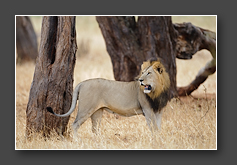
The four recordings that follow are a small sampler of the sounds of the African night.
They were made in Tanzania over the course of two weeks in late August and early September, at various
locations but using a similar recording technique: Each evening at dusk, I clamped my stereo microphone outside
our tent, aimed in a likely direction and positioned as far out from the tent as possible without putting it at
too much risk from Hyaena (who will chew anything they find), Elephant, and other animals that pass through
camp in the dark. The microphone was cabled back to the recorder inside the tent, so I could start and stop
recording while lying in bed listening to the night sounds.
In the first clip, two Lions—large black-maned pride males and brothers—roar
together in Tarangire National Park, advertising their presence to pride members and potential rival
males. These Lions were at very close range within the camp boundary, and you can hear the detail of the
guttural rasp in the calls.
|
 |
 |
 |
 |
 |
 |
|
 |
 |
 |
 |
 |
 |
 |
 |
 |
 |
 |
 |
Small-eared Galagos, Lake Manyara National Park, Tanzania |
August 2011 |
 |
 |
 |
Galagos (small nocturnal primates also known as Bushbabies) were abundant in the
woods around our camp in Lake Manyara National Park, even calling from the branches above as we used our
open-air shower in the evenings. In this clip are two exchanges of calls from trees close to the
microphone. (Keep the volume on your headphones turned down, because the sudden calls are quite loud!).
In the interlude between the Galago calls, Hippopotamus make their characteristic grunts in the distance.
This is Small-eared Greater Galago(Otolemur garnettii),
also called Garnett’s Greater Galago, Northern Greater Galago, and other common names by different
sources.
|
 |
 |
 |
 |
 |
 |
|
 |
 |
 |
 |
 |
 |
 |
 |
 |
 |
 |
 |
Elephant Browsing at Night, Ruaha National Park, Tanzania |
September 2011 |
 |
 |
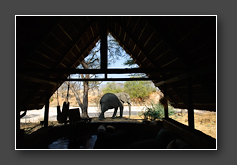
Most small safari camps in Africa are unfenced, and it is not uncommon to awake to the
sound of Elephant browsing near the tent at night (or indeed during the day as the photograph shows). In this
recording, made after midnight in Ruaha National Park, our visitor is tearing branches from a small Candelabra
tree just a few yards from the tent. Amid the crashing of vegetation, you can hear the grinding of the Elephant
chewing, and some other unexpected sounds I have annotated on the timeline. The musical note in the
background, repeated at regular short intervals, is African Scops-Owl.
|
 |
 |
 |
 |
 |
 |
|
 |
 |
 |
 |
 |
 |
 |
 |
 |
 |
 |
 |
Lion Echoes and Bats, Ruaha National Park, Tanzania |
September 2011 |
 |
 |
 |
Here we have Lion again, this time in Ruaha National Park, with the sound
echoing in the walls of the dry riverbed in front of our tent. In the foreground, are the wingbeats
of insect-hunting bats.
With identification help from the camp manager, these are probably Hairy Slit-faced Bat
(Nycteris hispida). We could see their size in the dim light before dawn as they passed in front of and
through the open areas of our tent, and N. hispida is the common insect-eating bat of this size in the
area.
|
 |
 |
 |
 |
 |
 |
|
 |
 |
 |
 |
 |
 |
 |
 |
 |
 |
 |
 |
Cope’s Gray Treefrogs, Monroe County, Indiana, USA |
July 2011 |
 |
 |
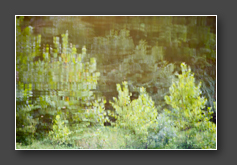
The following three recordings were made at the same small pond in southern Indiana over
the course of a hot and humid week in July 2011. This is the same location as the April ‘Frog
Chorus’ clip at the bottom of the page, but by July the Spring Peepers and Southern Leopard Frogs are
quiet, replaced by Cope’s Gray Treefrogs, Green Frogs and Bullfrogs.
On the day of the first recording it had reached 105°, and I’m sure it was
still well over 90° at midnight when this was captured. Cope’s Gray Treefrog is the main caller.
These are abundant in the surrounding woodland, and they descend to ponds at night to breed. I don’t
know if it was due to the weather or other factors, but their chorus was especially loud on this particular
evening.
The ‘plucked banjo string’ of Green Frogs can be heard periodically. I
am not an expert on frog vocalizations, but I believe the occasional ‘weep-weep’ is again
Cope’s Gray Treefrog. Distinct from the constant ‘advertisement’ call, this is an aggressive
call between rival males.
Toward the end something makes a loud splash which silences the frogs for several
minutes.
|
 |
 |
 |
 |
 |
 |
|
 |
 |
 |
 |
 |
 |
 |
 |
 |
 |
 |
 |
Green Frogs, Monroe County, Indiana, USA |
July 2011 |
 |
 |
 |
Green Frogs were regular callers, but this was the only time I heard such a concentration
of calls from multiple individuals. Each frog seems to be calling on a different beat, creating a strange syncopated
chorus. Twice Bullfrogs add their bass voice to the mix.
|
 |
 |
 |
 |
 |
 |
|
 |
 |
 |
 |
 |
 |
 |
 |
 |
 |
 |
 |
Barred Owl, Monroe County, Indiana, USA |
July 2011 |
 |
 |
 |
After midnight, sitting in the darkness listening to the frogs, I had no idea a Barred Owl
was close by until its slow trembling call came through the headphones.
|
 |
 |
 |
 |
 |
 |
|
 |
 |
 |
 |
 |
 |
 |
 |
 |
 |
 |
 |
Dawn Chorus, Surrey Hills, UK |
May 2011 |
 |
 |
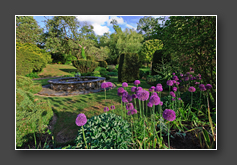
This recording of the dawn chorus of birdsong was made in our home garden in the
Surrey Hills south of London. In the background is a continuous calling of Woodpigeon, mixed with
the sounds of corvids passing overhead and the regular call and wingbeat of Pheasant. Multiple other
birds are heard through the recording, all common garden and countryside species in this part of the
UK. I have annotated just the more prominent sounds on the timeline.
Only 30 miles south of London and equidistant between Heathrow and Gatwick
airports, periods of quiet without human sounds are rare. Still, by May the best of the
dawn chorus occurs before the airports open, and early on weekend mornings when this was recorded
there are longer stretches without car traffic on the country lanes. There are still some brief
moments of faint mechanical sound, but they don't intrude and are soft enough that you may not
even pick them out.
|
 |
 |
 |
 |
 |
 |
|
 |
 |
 |
 |
 |
 |
 |
 |
 |
 |
 |
 |
Bees in Cotoneaster Bush, Surrey Hills, UK |
May 2011 |
 |
 |
 |
The blossoms of Cotoneaster horizontalis are tiny, but they still attract
swarms of bees to the small bush in our front garden during the peak of its flowering period. On this
day in mid-May the swarm was mostly Honeybees, with a few Red-tailed Bumblebees mixed in. I placed the
microphone next to the bush, and waited for a traffic-free minute on our country road.
|
 |
 |
 |
 |
 |
 |
|
 |
 |
 |
 |
 |
 |
 |
 |
 |
 |
 |
 |
Frog Chorus, Monroe County, Indiana, USA |
April 2011 |
 |
 |
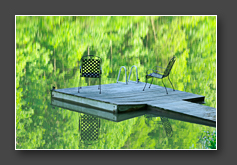
This is a section from one of the first few recordings I ever made.
When I ordered my microphone and recorder, they were delivered to my sister’s and her husband’s
home in southern Indiana in the USA. This frog chorus was captured after dark at a pond on their property
as I was learning how to make the outfit work.
The loud background is Spring Peepers, and the ‘chuckling’ call interspersed
through the recording is Southern Leopard Frog. In the latter stage, light rain starts to fall and
this seems to slightly mute the chorus.
|
 |
 |
 |
 |
 |
 |
|
 |
 |
 |
 |
 |
 |



